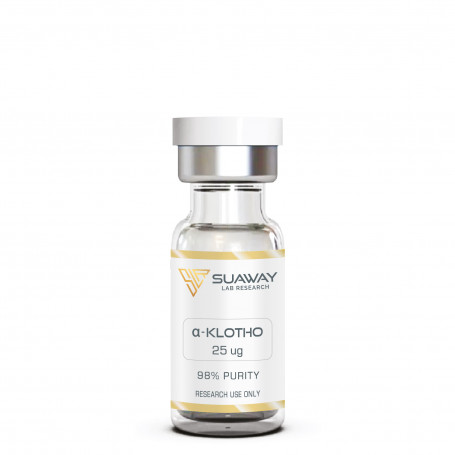Description
STRUCTURE
Sequence: EPGDGAQTWA RFSRPPAPEA AGLFQGTFPD GFLWAVGSAA YQTEGGWQQH GKGASIWDTF THHPLAPPGD SRNASLPLGA PSPLQPATGD VASDSYNNVF RDTEALRELG VTHYRFSISW ARVLPNGSAG VPNREGLRYY RRLLERLREL GVQPVVTLYH WDLPQRLQDA YGGWANRALA DHFRDYAELC FRHFGGQVKY WITIDNPYVV AWHGYATGRL APGIRGSPRL GYLVAHNLLL AHAKVWHLYN TSFRPTQGGQ VSIALSSHWI NPRRMTDHSI KECQKSLDFV LGWFAKPVFI DGDYPESMKN NLSSILPDFT ESEKKFIKGT ADFFALCFGP TLSFQLLDPH MKFRQLESPN LRQLLSWIDL EFNHPQIFIV ENGWFVSGTT KRDDAKYMYY LKKFIMETLK AIKLDGVDVI GYTAWSLMDG FEWHRGYSIR RGLFYVDFLS QDKMLLPKSS ALFYQKLIEK NGFPPLPENQ PLEGTFPCDF AWGVVDNYIQ VSQLTKPISS LTKPYH
Molecular Weight: 62.135 Da
Protein Purity: Greater than 98%
Other details: No TFA Salt, No Mannitol
Storage: Lyophilized protein must be stored at -20°C and protein solution at +4°C.
DESCRIPTION
The klotho protein was first discovered in 1997 by a research team in Japan, which also discovered the inhibitory effect that klotho has against some aspects of the aging process.
α-Klotho is a geroprotective factor that exerts anti-physiological stress effects and protects against oxidative damage, hypoxia, and cytotoxic drugs. It is an endocrine protein that regulates multiple biological processes, including phosphate homeostasis, mineral metabolism, and signaling by insulin-like growth factor 1 (IGF-1), mammalian target of rapamycin (mTOR), cyclic adenosine monophosphate (cAMP), p53/ p21, and Wnt proteins.
α-Klotho is synthesized and secreted by the distal renal tubule and so is present in urine. It is also highly expressed in the choroid plexus and other regions of the brain and to a lesser extent in adipose tissue. Several preclinical studies have implicated α-Klotho as a molecule that impacts lifespan, health-span, and renal and cognitive function. α-Klotho declines with ageing in mice and humans. Mice deficient in α-Klotho develop premature ageing-like phenotypes, including shortened lifespan, atherosclerosis-like vascular dysfunction, cognitive impairment, sarcopenia, physical dysfunction, cardiac hypertrophy and fibrosis, and osteopenia.
Conversely, high α-Klotho levels attenuate age-related functional declines. Mice overexpressing α-Klotho have increased lifespan, enhanced cognition, delayed age-related vascular dysfunction, decreased diabetes-related inflammation, and improved skeletal muscle regeneration.
Along with reductions in α-Klotho, senescent cells accumulate with ageing. Cellular senescence is a cell fate involving essentially permanent replicative arrest, extensive changes in metabolic state, and resistance to apoptosis. Senescent cell abundance is increased in multiple age-related diseases and disorders in experimental animals and humans. Cellular senescence can be associated with a SASP that entails release of pro-inflammatory and tissue-damaging cytokines, chemokines, extracellular matrix-destroying proteases, bioactive lipids, metabolites, nucleotides, exosomes, pro-apoptotic factors, and factors that impede stem cell, progenitor, and tissue function and can spread senescence to previously normal cells, both locally and systemically.
Reducing senescent cell burden with senolytics, a class of drugs that selectively clears senescent cells, extends health-span in mice and has effects similar to those of overexpressing or administering recombinant α-Klotho. Conversely, transplanting senescent cells into young mice shortens health-span and causes frailty, early onset of age-related phenotypes and diseases, and premature death from the same causes of death as naturally-aged mice.
Collectively, these findings suggest a feed-forward cycle, with deficiency of α-Klotho contributing to increased senescent cell burden and hence increased SASP factors that, in turn, might further exacerbate α-Klotho deficiency. If so, decreasing senescent cell abundance using orally-active senolytics could be a clinically effective and practical way to increase α-Klotho.
To determine if senolytics increase α-Klotho and explore translational relevance, researchers performed post hoc specimen analyses of urinary α-Klotho in three different mouse models and the first human study of the senolytic drug combination, D+Q, in persons with IPF. IPF is a progressive, fatal age-related disease linked to both cellular senescence and reduced α-Klotho. Bleomycin inhalation induces lung senescent cell accumulation together with an IPF-like syndrome in mice that is alleviated by decreasing senescent cell burden genetically or with senolytics. Also, lung α-Klotho is lowered by Bleomycin administration. Transgenic mice overexpressing α-Klotho are protected from Bleomycin-induced pulmonary fibrosis.
Patients with IPF have decreased plasma α-Klotho as well as an increased burden of senescent cells.
Only around 20 percent of people have high levels of klotho, which appears to protect the brain from neurodegenerative diseases, such as Alzheimer’s.
During her studies, researchers have found that by simply injecting a form of the protein directly into mice, she could give them the same effect that genetically high klotho levels have and that brain function improved within just four hours of a single treatment.
REFERENCES
Makoto Kuro-O "The Klotho proteins in health and disease" [PubMed]
Q.Yuan et al., "A Klotho-derived peptide protects against kidney fibrosis by targeting TGF-β signaling" [PubMed]
G.J. Prud'homme et al., "Pathobiology of the Klotho Antiaging Protein and Therapeutic Considerations" [PubMed]
S. Yokojama et al., "A klotho gene single nucleotide polymorphism is associated with the onset of stroke and plasma klotho concentration" [PubMed]
J. Leon et al., "Peripheral Elevation of a Klotho Fragment Enhances Brain Function and Resilience in Young, Aging, and α-Synuclein Transgenic Mice" [PubMed]
H. Kurosu et al., "The Klotho gene family as a regulator of endocrine fibroblast growth factors" [PubMed]
Makoto Kuro-O "Klotho and calciprotein particles as therapeutic targets against accelerated ageing" [PubMed]
P-Urena Torres et al., "Klotho: an antiaging protein involved in mineral and vitamin D metabolism" [PubMed]
Yo-ichi Nabeshima "Klotho: a fundamental regulator of aging" [PubMed]
T. Isakova et al., "A Klotho-Derived Peptide as a Possible Novel Drug to Prevent Kidney Fibrosis" [PubMed]
M. Torbus-Paluszczak et al., "Klotho protein in neurodegenerative disorders" [PubMed]
M. Dermaku-Sopjani et al., "Significance of the anti-aging protein Klotho" [PubMed]
DISCLAIMER
This product is intendend for lab research and development use only. These studies are performed outside of the body. This product is not medicines or drugs and has not been approved by the FDA or EMA to prevent, treat or cure any medical condition, ailment or disease. Bodily introduction of any kind into humans or animals is strictly forbidden by law. This product should only be handled by licensed, qualified professionals.
All product information provided on this website is for informational and educational purposes only.


